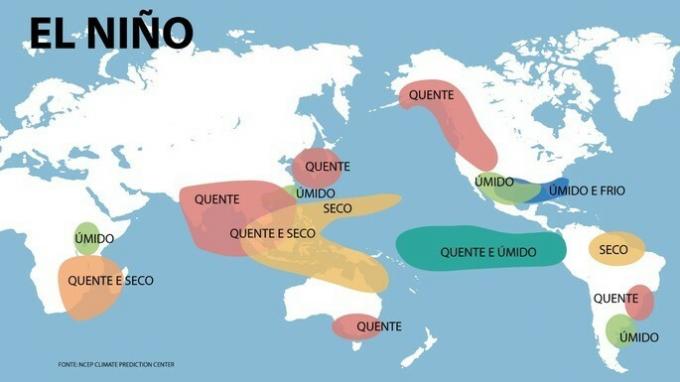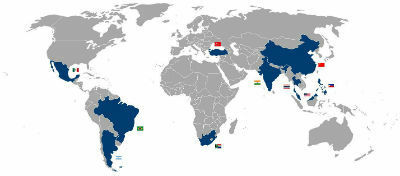The El Niño or El Niño Southern Oscillation (ENOS) is a natural phenomenon that happens irregularly, with frequency of 2 to 7 years, and generates climate change in the central and eastern portions of the Pacific Ocean Equatorial.
Occurs for 3 to 4 months in the southern hemisphere and covers the surrounding countries of the Pacific Ocean, such as the region between Indonesia, Australia and the coast of Peru.
It is worth noting that his name “El Niño”, from Spanish, means “the boy”. This designation comes from the time when the same happens, close to the birth of the Child Jesus (25 December), at the end of the year.
Summary about El Niño
Registered since 1877, El Niño has become a topic on the agenda of meteorologists. This happened more precisely in the late 1990s, as in 1997 and 1998 a strong El Niño was found on the west coast of South America, with an elevation of almost two and a half degrees of the ocean.
According to surveys, for the year 2014 another intense event would be expected, a fact that did not happen.
However, it was in 1982 and 1983 that the strongest El Niño was recorded, with a warming of approximately 6 °C in the temperature of the Pacific Ocean.

Note that to be considered “El Niño”, the phenomenon has to last for at least 3 months, so that the sea temperature tends to rise by at least half a degree.
El Niño signals the warming of the Pacific Ocean's climatic waters as the trade winds (winds that blow in the tropics in the Ecuador region from east to west) decrease and thus cause the warming of sea waters.
This affects nearby regions, resulting in lack or excess of rain and temperature rises. Thus, the Humbolt current affects the coast of Latin American countries such as Peru and Chile.
For fishermen in the region, this phenomenon, in addition to shaking the climate, affects the economy. This is because there is a great reduction in fish and other marine animals during the occurrence of El Niño.
El Niño in Brazil
El Niño affects much of the globe, causing considerable climate change, from excessive heating or intense humidity.
In Brazil, the phenomenon affects the rainfall index in certain regions, in addition to being responsible for the increase in temperatures.
Thus, in the north and northeast of the country, periods of drought and drought are intensified. This unbalances the local fauna and flora, causing a greater number of fires.
Meanwhile, in the southeast and south regions of the country, there is a large increase in the amount of rain. This, in a way, also affects the surrounding nature with landslides, floods, rising river levels, among others.
El Niño in the World
Other regions of the globe are affected by El Niño, such as: the Pacific Islands, Australia, India, Indonesia and Southeast Africa.
They suffer from the drop in rainfall during the summer, which would normally be wetter, which generates significant losses of fauna and flora.
Likewise, some countries in South America suffer from lack of rain and rising temperatures, for example, Chile, Bolivia, and Peru.
In turn, on the west coast of South America and North America, countries such as Canada and the United States suffer from the notorious increase in rainfall, which has led to numerous catastrophes and floods.
La Niña
Another atmospheric-oceanic phenomenon that presents characteristics opposite to El Niño is called La Niña (which means “girl” in Spanish).
In this phenomenon, the abnormal water cooling from the ocean for periods of approximately 9 to 12 months, as a result of the increased intensity of the trade winds.
Like El Niño, this phenomenon occurs irregularly, that is, from 2 to 7 years. The most recent and significant episodes of La Niña occurred in the years 1988-1989 (one of the most intense), 1995-1996 and 1998-1999.

